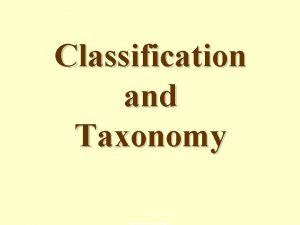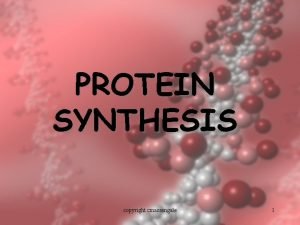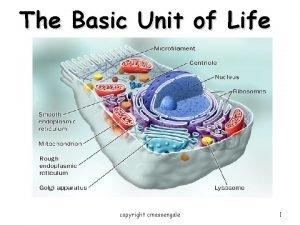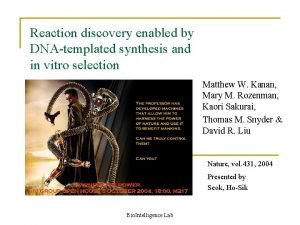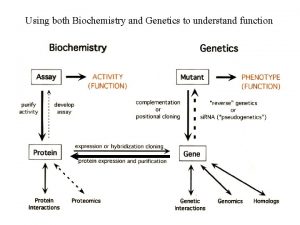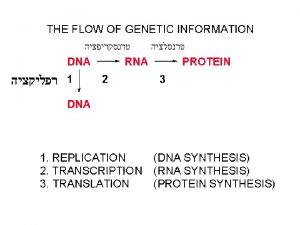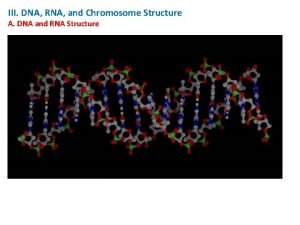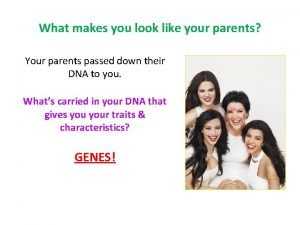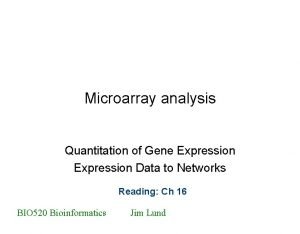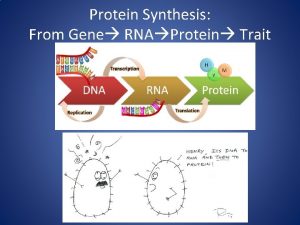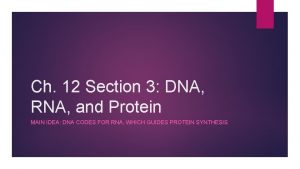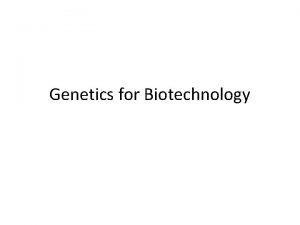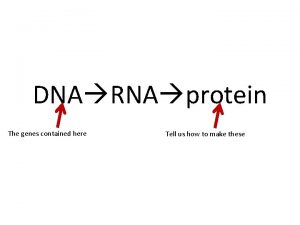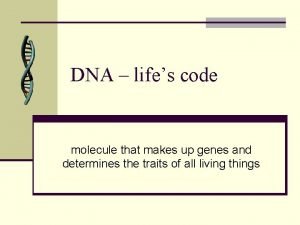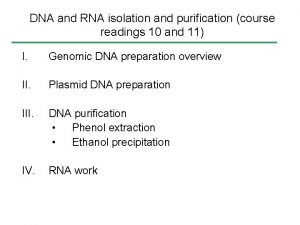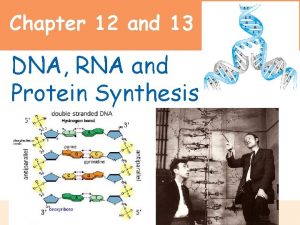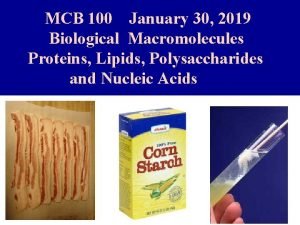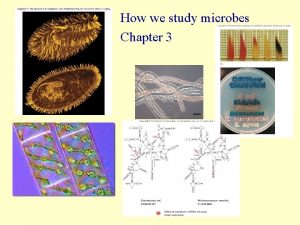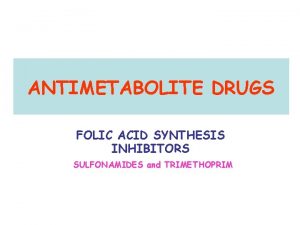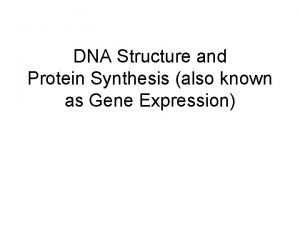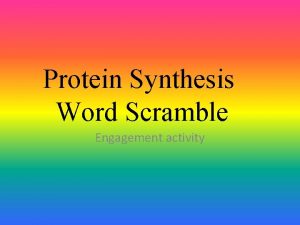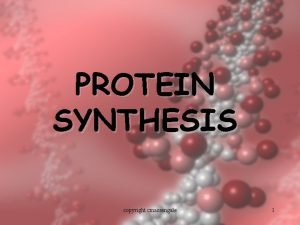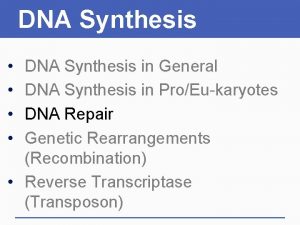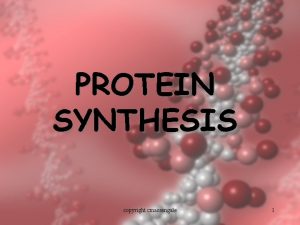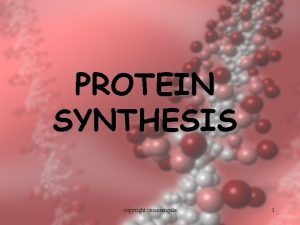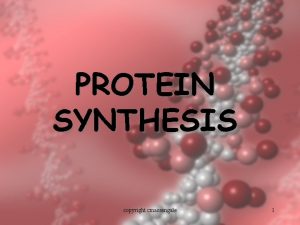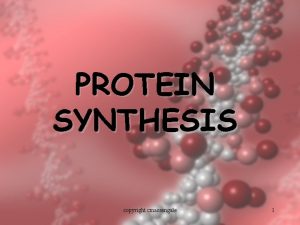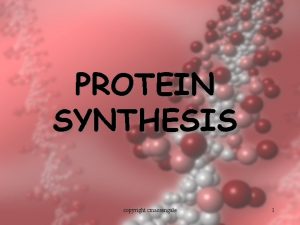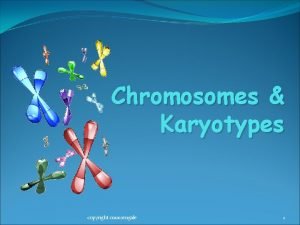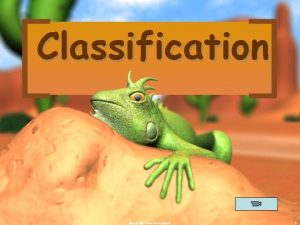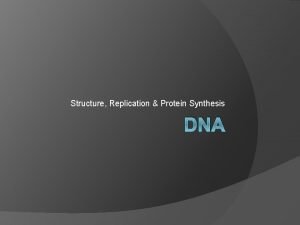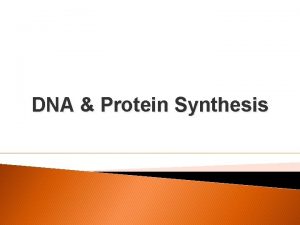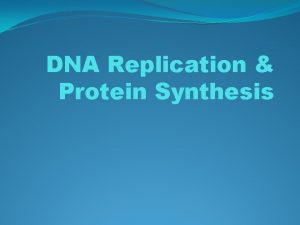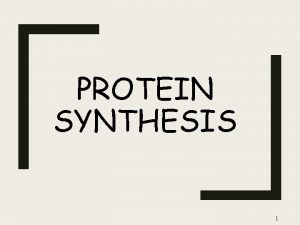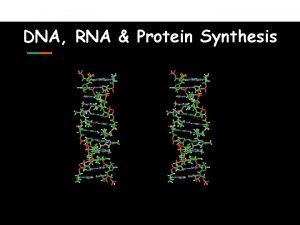PROTEIN SYNTHESIS copyright cmassengale 1 Protein Synthesis DNA






























- Slides: 30

PROTEIN SYNTHESIS copyright cmassengale 1

Protein Synthesis • DNA ‘s code must be copied and taken to the ribosomes. • In the ribosomes, this code must be read so amino acids can be assembled to make proteins. • This process is called PROTEIN SYNTHESIS copyright cmassengale 2

RNA copyright cmassengale 3

Roles of RNA and DNA • DNA is the MASTER PLAN • RNA is the BLUEPRINT (copy) of the Master Plan copyright cmassengale 4

RNA Differs from DNA • RNA has a sugar ribose DNA has a sugar deoxyribose copyright cmassengale 5

Other Differences • • RNA contains the base uracil (U) DNA has thymine (T) RNA molecule is single-stranded DNA is doublestranded copyright cmassengale DNA 6

Structure of RNA copyright cmassengale 7

Remember the Complementary Bases On DNA: A-T C-G On RNA: A-U C-G copyright cmassengale 8

. Three Types of RNA • Messenger RNA (m. RNA) copies DNA’s code & carries the genetic information to the ribosomes • Ribosomal RNA (r. RNA), along with protein, makes up the ribosomes • Transfer RNA (t. RNA) transfers amino acids to the ribosomes where proteins are synthesized copyright cmassengale 9

Messenger RNA • Long Straight chain of Nucleotides • Made in the Nucleus • Copies DNA & carries info to ribosomes. copyright cmassengale 10

Ribosomal RNA (r. RNA) • Globular in shape • Are part of the ribosomes actual structure. • Site of protein Synthesis (where the proteins are made) copyright cmassengale 11

Transfer RNA (t. RNA) • Clover-leaf shape • Single stranded molecule. • Attachment site at one end for an amino acids. • Opposite end has three nucleotide bases called the anticodon. copyright cmassengale 12

Transfer RNA amino acid attachment site U A C anticodon copyright cmassengale 13

Codons and Anticodons • The 3 bases of an anticodon are complementary to the 3 bases of a codon • Example: Codon ACU Anticodon UGA copyright cmassengale UGA ACU 14

Transcription and Translation (The actual making of a protein. ) copyright cmassengale 15

Protein Synthesis § The production or synthesis of proteins. § Two phases: Transcription & Translation copyright cmassengale 16

Transcription • The process of copying the sequence of one strand of DNA, the template strand. • m. RNA copies the template strand. copyright cmassengale 17

Transcription • During transcription, RNA polymerase binds to DNA and separates the DNA strands • RNA Polymerase then uses one strand of DNA as a template to assemble nucleotides into RNA copyright cmassengale 18

Transcription • Promoters are regions on DNA that show where RNA Polymerase must bind to begin the Transcription of RNA Called the TATA box. copyright cmassengale 19

Transcription • Specific base sequences act as signals to stop Called the termination signal. • Once the Polymerase is done it falls off, the DNA re-zips up and the m. RNA escapes out the nucleus. copyright cmassengale 20

m. RNA Transcript • m. RNA leaves the nucleus through its pores and goes to the ribosomes. copyright cmassengale 21

Translation • Translation is the process of decoding the m. RNA into a protein. • Ribosomes read m. RNA three bases or 1 codon at a time and construct the proteins copyright cmassengale 22

Step 1 - Initiation • m. RNA enters the ribosome and attaches to the t. RNA. The t. RNA has an anticodon that matches with the three “start” nucleotides. 23

Initiation amino 2 -t. RNA 1 -t. RNA anticodon hydrogen bonds U A C A U G codon aa 2 G A U C U A C U U C G A copyright cmassengale m. RNA 24

Step 2 - Elongation • The ribosome moves down the m. RNA strand. • The first t. RNA detaches and leaves it’s amino acid. • Two new t. RNA with their amino acids move into position (positions are called A and P) • The new t. RNAs have the correct amino acid for that specific codon. Each copyright cmassengale 25 amino Acid forms a bond.

Amino 1 peptide bonds Amino 2 Amino 4 Amino 3 4 -t. RNA 2 -t. RNA A U G 3 -t. RNA G C U G A A C U U C G A A C U m. RNA copyright cmassengale 26

Amino 1 peptide bonds Amino 5 Amino 2 Amino 3 Amino 4 5 -t. RNA U G A 3 -t. RNA 4 -t. RNA G A A G C U A C U U C G A A C U m. RNA copyright cmassengale 27

Termination • t. RNA’s will continue to read m. RNA and hook up amino acids until “stop” codon is reached. • A “stop” codon is three nucleotides on the m. RNA that t. RNA does not have an anticodon for. copyright cmassengale 28

Dissaembly • When the stop codon is reached the ribosome falls off, the protein goes into the body, and the t. RNAs go out to find more amino acids. • The ribosome will go find another strand of m. RNA and the 29 whole process starts over.

End Product –The Protein! • The end products of protein synthesis is a primary structure of a protein • A sequence of amino acid bonded together by peptide bonds 2 1 3 4 5 199 copyright cmassengale 200 30
 Dna and genes chapter 11
Dna and genes chapter 11 Classification groups in order
Classification groups in order Cmassengale
Cmassengale Cmassengale
Cmassengale Dna rna and protein synthesis study guide
Dna rna and protein synthesis study guide Bioflix activity dna replication dna replication diagram
Bioflix activity dna replication dna replication diagram Coding dna and non coding dna
Coding dna and non coding dna What are the enzymes involved in dna replication
What are the enzymes involved in dna replication Function of dna polymerase 3
Function of dna polymerase 3 Dna-templated synthesis
Dna-templated synthesis Dna synthesis at replication fork
Dna synthesis at replication fork Dna synthesis
Dna synthesis Dna and rna diagram
Dna and rna diagram Que es
Que es Dna rna protein
Dna rna protein Protein
Protein Chapter 12 section 3 dna rna and protein
Chapter 12 section 3 dna rna and protein Mutations quiz
Mutations quiz Dna rna protein
Dna rna protein Dna and rna concept map
Dna and rna concept map Dna rna protein diagram
Dna rna protein diagram Dna to protein steps
Dna to protein steps Dna-protein interactions
Dna-protein interactions Protein synthesis
Protein synthesis Paba
Paba Protein synthesis and mutations
Protein synthesis and mutations Messenger rna codons
Messenger rna codons Protein synthesis
Protein synthesis Protein synthesis scramble
Protein synthesis scramble Pap protein synthesis worksheet
Pap protein synthesis worksheet 4 steps of protein synthesis
4 steps of protein synthesis

